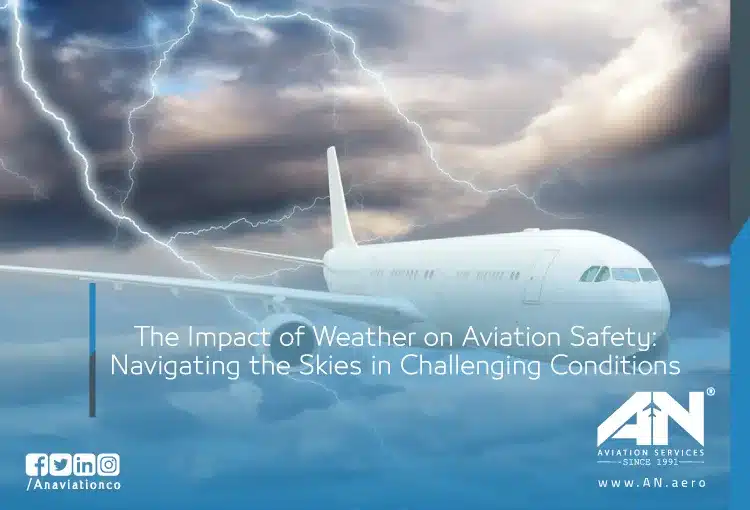
Weather is one of the most critical factors influencing aviation safety. For the aviation industry, adverse weather conditions can create significant challenges that affect flight planning, operations, and overall safety. From sudden wind shear to icy runways, the unpredictability of weather events makes navigating the skies a complex task.
This blog delves into the various ways weather impacts aviation safety, and how the industry has adapted with advanced technologies, real-time forecasting, and strategic planning to ensure safety in even the most challenging conditions.
Weather’s Role in Aviation Safety
The aviation industry is deeply intertwined with weather patterns, as even minor fluctuations can disrupt flight operations. Whether it’s a clear, calm day or a stormy night, pilots and air traffic controllers rely heavily on weather information to make informed decisions.
- Wind Shear and Strong Winds: Sudden changes in wind speed or direction—commonly known as wind shear—can pose significant risks during takeoff and landing. Strong winds can disrupt the trajectory of an aircraft, leading to potential hazards if not managed carefully.
- Icing Conditions: Ice accumulation on aircraft surfaces can severely impact aerodynamics, causing reduced lift and increased drag. De-icing procedures and specialized systems ensure that planes remain safe to fly, particularly in colder climates.
- Visibility Issues: Poor visibility caused by fog, rain, or snow can challenge pilots during critical phases like takeoff, approach, and landing. In such scenarios, instrument landing systems (ILS) become vital in guiding aircraft safely to the ground.
- Thunderstorms and Turbulence: Severe weather events, including thunderstorms, can result in turbulence and increased risk for aircraft. Turbulence, though common, can affect passenger comfort and sometimes cause minor injuries if not anticipated.
The Impact of Weather on Operations
Weather doesn’t just influence safety; it also affects the efficiency and scheduling of air travel.
- Flight Delays and Cancellations: Adverse weather conditions are one of the leading causes of flight delays and cancellations worldwide. Airlines must adjust flight schedules to minimize disruptions, often relying on real-time weather updates to plan alternative routes.
- Hazardous Weather and Route Adjustments: Pilots and flight planners monitor hazardous weather in real-time to determine alternative flight paths. For instance, flying around a storm rather than through it ensures passenger safety but may increase travel time.
- Airport Operations in Extreme Weather: Airports have their own set of challenges when managing adverse weather. De-icing procedures, clearing snow from runways, and ensuring proper drainage during heavy rainfall are critical tasks handled by ground teams to maintain safe airport operations.
Navigating the Skies with Advanced Technology
The aviation industry has made significant strides in mitigating weather-related risks with cutting-edge technology and tools.
- Real-Time Weather Forecasting: Modern weather systems provide real-time data to pilots and air traffic controllers, allowing them to respond to sudden weather changes effectively. This ensures quick decision-making and reduces risks during flight.
- Instrument Landing Systems (ILS): ILS is a crucial tool in low-visibility conditions, guiding pilots through precise signals to land safely even when weather conditions obscure the runway.
- De-Icing Technologies: Aircraft de-icing procedures involve the use of specialized fluids and systems to ensure that ice doesn’t affect flight operations. Airports are equipped with dedicated de-icing pads to streamline the process.
- Weather Radar Systems: Aircraft are equipped with weather radar systems to detect precipitation and turbulence ahead, enabling pilots to take corrective actions well in advance.
- Artificial Intelligence and Big Data: AI-powered tools analyze vast amounts of weather data to predict patterns and provide highly accurate forecasts, enhancing the efficiency of flight planning and air traffic management.
Human Role in Weather Navigation
While technology has revolutionized how weather impacts are managed, the role of humans remains vital.
- Air Traffic Controllers: Controllers monitor weather conditions and provide critical information to pilots about wind speed, visibility, and turbulence. They play a key role in coordinating safe takeoffs and landings.
- Flight Crews and Pilots: Pilots undergo extensive training to handle various weather scenarios, from flying through turbulence to managing emergencies during storms.
- Ground Teams: At airports, ground teams work tirelessly to clear runways, apply de-icing agents, and maintain airport infrastructure during severe weather.
Planning for the Unpredictable
Aviation safety relies heavily on meticulous planning. Airlines, airports, and regulatory authorities collaborate to create robust procedures for handling weather-related challenges.
- Flight Planning: Flight plans are meticulously designed, taking into account weather forecasts, wind speeds, and potential turbulence along the route.
- Emergency Preparedness: Airlines and airports have detailed protocols to handle emergency scenarios caused by extreme weather, ensuring passenger safety and maintaining operational efficiency.
- Collaborative Efforts: The aviation sector, including organizations like the National Oceanic and Atmospheric Administration (NOAA), plays a crucial role in improving weather forecasting accuracy and ensuring better preparedness for adverse conditions.
Conclusion: Weather and the Future of Aviation Safety
The impact of weather on aviation safety is undeniable, but advancements in technology, coupled with skilled professionals, have made air travel safer than ever. From real-time weather forecasting to robust de-icing technologies, the industry continues to evolve, ensuring that challenges posed by adverse weather are met with confidence and precision.
Navigating the skies in challenging conditions requires a harmonious blend of technology, expertise, and strategic planning. As the aviation industry grows, its ability to adapt to changing weather patterns will remain a cornerstone of its commitment to safety and reliability.

